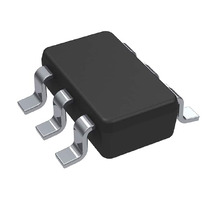Manufacturer Part Number
TLV61048DBVR
Manufacturer
Texas Instruments
Introduction
The TLV61048DBVR is a step-up boost converter from Texas Instruments, specifically designed for power management applications requiring a regulated higher voltage from a lower voltage source.
Product Features and Performance
Supports input voltages from 2.65V to 5.5V
Adjustable output voltage range from 3.3V to 14V
Can switch at frequencies of 550kHz or 1MHz
Operates at a temperature range of -40°C to 125°C
Surface Mount SOT-23-6 package for compact design
Product Advantages
High efficiency step-up voltage conversion
Adjustable output for flexible usage across different applications
Suitable for battery-operated devices due to low input voltage capability
High switching frequency allows for smaller external components
Key Technical Parameters
Boost topology
Positive output configuration
Single output channel
65V minimum input voltage
5V maximum input voltage
3V minimum adjustable output voltage
14V maximum adjustable output voltage
Operating temperature range -40°C to 125°C
Quality and Safety Features
Robust operating temperature range for reliability in varying environments
Manufactured by Texas Instruments, known for quality in semiconductor products
Compatibility
Compatible with a variety of low-voltage sources
SOT-23-6 package standard for ease of use with standard PCB designs
Application Areas
Battery-powered devices
Portable electronics
Low-power embedded systems
Energy harvesting
IoT devices
Product Lifecycle
Active status, not currently near discontinuation
Availability of future replacements or upgrades as per Texas Instruments' product management
Several Key Reasons to Choose This Product
Strong performance in converting and boosting voltages in power-sensitive applications
Texas Instruments' reputation for producing high-quality and reliable components
The device's capacity to handle a broad range of input and output voltages, providing flexibility in electrical design
Built-in features like adjustable switching frequency allow optimization for efficiency or size reduction in circuit design
Good thermal performance enhances device longevity and stability



 TLV61046ATexas Instruments
TLV61046ATexas Instruments TLV6002QDRQ1Texas InstrumentsIC OPAMP GP 2 CIRCUIT 8SOIC
TLV6002QDRQ1Texas InstrumentsIC OPAMP GP 2 CIRCUIT 8SOIC TLV620612TDSGRQ1Texas InstrumentsIC REG BUCK 1.2V 1.6A 8WSON
TLV620612TDSGRQ1Texas InstrumentsIC REG BUCK 1.2V 1.6A 8WSON TLV61046ADBVTTexas InstrumentsIC REG BOOST ADJ SOT23-6
TLV61046ADBVTTexas InstrumentsIC REG BOOST ADJ SOT23-6 TLV6004IPWRTexas InstrumentsIC OPAMP GP 4 CIRCUIT 14TSSOP
TLV6004IPWRTexas InstrumentsIC OPAMP GP 4 CIRCUIT 14TSSOP